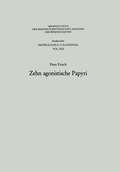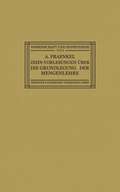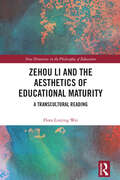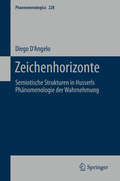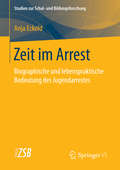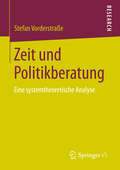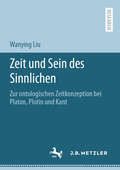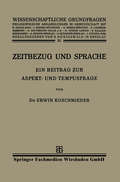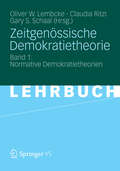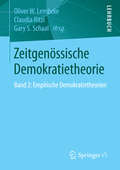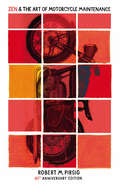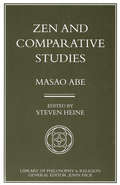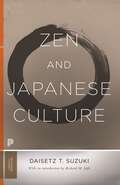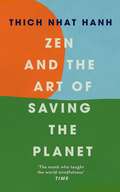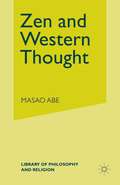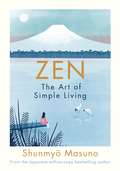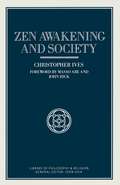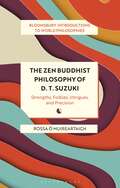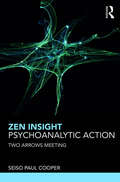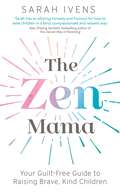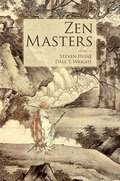- Table View
- List View
Zehn agonistische Papyri (Abhandlungen der Rheinisch-Westfälischen Akademie der Wissenschaften #13)
by Peter FrischZehn Vorlesungen Über die Grundlegung der Mengenlehre: Gehalten in Kiel auf Einladung der Kant-Gesellschaft, Ortsgruppe Kiel, vom 8.–12. Juni 1925 (Wissenschaft und Hypothese)
by Adolf FraenkelDieser Buchtitel ist Teil des Digitalisierungsprojekts Springer Book Archives mit Publikationen, die seit den Anfängen des Verlags von 1842 erschienen sind. Der Verlag stellt mit diesem Archiv Quellen für die historische wie auch die disziplingeschichtliche Forschung zur Verfügung, die jeweils im historischen Kontext betrachtet werden müssen. Dieser Titel erschien in der Zeit vor 1945 und wird daher in seiner zeittypischen politisch-ideologischen Ausrichtung vom Verlag nicht beworben.
Zehou Li and the Aesthetics of Educational Maturity: A Transcultural Reading (New Directions in the Philosophy of Education)
by Flora Liuying WeiThis book articulates a unique conception of aesthetic educational philosophy and its relation to the Chinese world, drawing on the works of the prominent contemporary Chinese philosopher Zehou Li. The book outlines an aesthetics approach to educational maturity that recognises both the contributions of Western Enlightenment ideals and Chinese traditions, paving the way for an inclusive and post-comparative philosophy. It offers a nuanced discussion of Zehou Li’s thought and how his work can be framed at the border between traditional and modern China, between China and the West. The book combines a discussion of aesthetics with educational theory and considers their combined implications for educational practice (in particular in the first-person perspectives of students, parents, and teachers), in both local and global contexts. Providing a way of doing philosophy of education that carefully considers interactions and overlaps between Western and Chinese civilisation, the book will be of great interest to researchers, academics and postgraduate students in the fields of educational philosophy, educational theory, Chinese and cross-cultural philosophy.
Zehou Li and the Aesthetics of Educational Maturity: A Transcultural Reading (New Directions in the Philosophy of Education)
by Flora Liuying WeiThis book articulates a unique conception of aesthetic educational philosophy and its relation to the Chinese world, drawing on the works of the prominent contemporary Chinese philosopher Zehou Li. The book outlines an aesthetics approach to educational maturity that recognises both the contributions of Western Enlightenment ideals and Chinese traditions, paving the way for an inclusive and post-comparative philosophy. It offers a nuanced discussion of Zehou Li’s thought and how his work can be framed at the border between traditional and modern China, between China and the West. The book combines a discussion of aesthetics with educational theory and considers their combined implications for educational practice (in particular in the first-person perspectives of students, parents, and teachers), in both local and global contexts. Providing a way of doing philosophy of education that carefully considers interactions and overlaps between Western and Chinese civilisation, the book will be of great interest to researchers, academics and postgraduate students in the fields of educational philosophy, educational theory, Chinese and cross-cultural philosophy.
Zeichenhorizonte: Semiotische Strukturen in Husserls Phänomenologie der Wahrnehmung (Phaenomenologica #228)
by Diego D’AngeloIn diesem Band deckt Diego D'Angelo semiotische Strukturen in der Husserl’schen Phänomenologie der Wahrnehmung auf. Ist es der Phänomenologie darum zu tun, die Erfahrung von Dingen in unserer Umwelt zu beschreiben, so ist dabei der Begriff des Horizontes von zentraler Bedeutung: Was wir unmittelbar wahrnehmen, verweist immer schon auf anderes, was nur „mitgegeben“ ist. Wenn wir Dinge wahrnehmen, haben wir nur eine bestimmte Perspektive, d.h. wir sehen lediglich einen Aspekt. Aber wir nehmen immer ganze Gegenstände wahr (wir sehen Tische und Stühle und andere Menschen). Jeder dieser Gegenstände erscheint in einem Feld weiterer Gegenstände, und es ist der Horizontbegriff, der es erlaubt, das Verhältnis zwischen Selbstgegebenheit und Mitgegebenheit zu explizieren.Dieses Buch stellt den ersten detaillierten Versuch dar, die Ursprünge solcher horizontaler Felder in semiotischen Strukturen zu suchen. Aus der Verbindung zwischen Husserls eigener Semiotik und seiner Phänomenologie der Wahrnehmung ergibt sich, dass das wahrgenommene Phänomen als Zeichen verstanden werden muss. Das Zeichen wiederum bezeichnet etwas, was in leiblicher Bewegung eingeholt werden kann. Mit der Verbindung von Leiblichkeit, Semiotik und Wahrnehmung thematisiert diese Monographie das Verhältnis zwischen folgenden phänomenologischen Forschungsgebieten:• Husserls Semiotik der Wahrnehmung in den Logischen Untersuchungen • Phänomenologische Raumanalyse – kinästhetische Indikation• Horizont und Noema• Passive Anzeige• Zeichen und Leiblichkeit als Grundlagen der Fremderfahrung• Genetische Phänomenologie und Semiotik der Erfahrung• Protentionen und teleologische Semiose• Induktion und Ursprung des menschlichen IchsDas Buch eröffnet die Möglichkeit, Husserls Phänomenologie jenseits einer Metaphysik der Präsenz zu verstehen. Zudem leisten D'Angelos Einzeluntersuchungen einen Beitrag zu aktuellen Diskussionen in der Philosophie der leiblichen Kognition. – Eine hilfreiche Leseempfehlung für • Interessierte Themenneulinge • Bachelor- und Masterstudenten der Geisteswissenschaften• Hochschulabsolventen sowie Forschungswissenschaftler
Zeit im Arrest: Biographische und lebenspraktische Bedeutung des Jugendarrestes (Studien zur Schul- und Bildungsforschung #71)
by Anja EckoldAnja Eckold sondiert die umstrittene und kontrovers diskutierte Maßnahme Jugendarrest historisch und analysiert sie am Beispiel einer Arrestanstalt. Den Hauptteil der Arbeit bilden ihre empirisch-biographieanalytischen Fallstudien mit Arrest verbüßenden Jugendlichen. Die Autorin stellt die Frage nach der biographischen und lebenspraktischen Bedeutung des Jugendarrests für die Jugendlichen und untersucht, wie sich diese zu juristisch intendierten Zielsetzungen und erzieherischen, pädagogischen und präventiven Zielen verhält. Mit diesem Schwerpunkt gelingt eine kritische Auseinandersetzung mit abgehobenen und empiriefernen Vorstellungen zur Bedeutung von Jugendarrest.
Zeit und Politikberatung: Eine systemtheoretische Analyse
by Stefan VorderstraßeDas Verhältnis von Politik und Zeit ist in der Politikwissenschaft oftmals vernachlässigt. Stefan Vorderstraße legt den Fokus auf die Bedeutung von Zeit in Strukturen und Prozessen der Politikberatung. Politische Entscheidungsträger sehen sich unter den Bedingungen einer stets gegenwärtig entscheidungsabhängigen und ungewissen Zukunft dem Problem ausgesetzt, kollektiv verbindliche Entscheidungen treffen zu müssen. Politik ist zudem mit einem Koordinierungsbedarf konfrontiert, dem sie über Politikberatung zu begegnen versucht. Auf Basis systemtheoretischer Konzepte geht der Autor der Frage nach, ob und mit Hilfe welcher Beratungsformen Politik den Anforderungen sozialer Gleichzeitigkeit in der funktional differenzierten Gesellschaft gerecht werden kann. Politische Entscheidungsprozesse und politikwissenschaftliche Analyseansätze konfrontiert er mit typischen Charakteristika der zunehmend beschleunigten Gesellschaft. Er plädiert für eine kombinierte Betrachtung von Sach-, Sozial- und Zeitdimension und leistet einen grundlegenden Beitrag zum Verständnis der Bedeutung von Zeit in und für Politikberatung.
Zeit und Sein des Sinnlichen: Zur ontologischen Zeitkonzeption bei Platon, Plotin und Kant
by Wanying LiuIn dem allgemeinen Denkmodus des antiken Platonismus (Platon und Plotin) und Kants wird das Sein der sinnlichen, in der Zeit existierenden Dinge apriorisch von dem als „zeitlos“ verstandenen Denken bestimmt und erfasst. Mit der Untersuchung der Grundgedanken Platons, Plotins und Kants kommt das Buch zur Konklusion, dass die apriorische Bestimmung und Erfassung des Seins in diesem Denkmodus erst durch diejenige Zeit möglich ist, die von der Autorin als „ontologische Zeit“ bestimmt wird. Die Art und Weise, wie die ontologische Zeit zu diesem Zweck dient, wird in diesem Buch erforscht. Während für den antiken Platonismus die Zeit, indem sie das Intelligible auf das Sinnliche überträgt, als das bestimmende Prinzip des Seins der sinnlichen Dinge gilt, ist der Fall bei Kant aber komplizierter, da hier die verschiedenen Aspekte des Seins unterschiedlich begründet werden müssen: die ontologische Zeit fungiert mit ihrer strukturellen Affinität zu den Kategorien als das Prinzip des Was-Seins der sinnlichen Gegenstände, während der Raum das Prinzip des Dass-Seins derselben ist, sofern die Äußerlichkeit der Raum-Zeit-Anschauungsformen in Beziehung auf den Verstand mit dem Argumentationsversuch der Autorin beseitigt wird.
Zeitbezug und Sprache: Ein Beitrag zur Aspekt- und Tempusfrage (Wissenschaftliche Grundfragen)
by Erwin KoschmiederDieser Buchtitel ist Teil des Digitalisierungsprojekts Springer Book Archives mit Publikationen, die seit den Anfängen des Verlags von 1842 erschienen sind. Der Verlag stellt mit diesem Archiv Quellen für die historische wie auch die disziplingeschichtliche Forschung zur Verfügung, die jeweils im historischen Kontext betrachtet werden müssen. Dieser Titel erschien in der Zeit vor 1945 und wird daher in seiner zeittypischen politisch-ideologischen Ausrichtung vom Verlag nicht beworben.
Zeitgenössische Demokratietheorie: Band 1: Normative Demokratietheorien
by Oliver Lembcke Claudia Ritzi Gary S. SchaalDas Buch diskutiert die zentralen Demokratietheorien der letzten Jahrzehnte nach einem einheitlichen Analyseschema. Die Einzeldarstellungen sind eingebettet in die Erörterung der größeren Entwicklungslinien innerhalb der vier zentralen demokratietheoretischen Paradigmen.
Zeitgenössische Demokratietheorie: Band 2: Empirische Demokratietheorien
by Oliver W. Lembcke Claudia Ritzi Gary S. SchaalDie Demokratie – verstanden als politische Selbstbestimmung eines Volkes – ist die vornehmste Aufgabe und der zentrale Gegenstand der Politischen Theorie. Das zweibändige Lehrwerk bietet eine systematische Einführung in die zeitgenössische normative und empirische Demokratietheorie. Der zweite Band behandelt wichtige empirische Theorieansätze. Alle Beiträge sind vergleichbar aufgebaut: Sie enthalten neben einer Verortung des jeweiligen Konzeptes in der Theoriegeschichte eine umfassende Darstellung seiner zentralen Aussagen und empirischen Forschungsergebnisse. Darauf aufbauend erfolgen methodenkritische Betrachtungen und aktuelle Forschungsbezüge werden aufgezeigt. Das zweibändige Lehrbuch bietet alle wesentlichen Grundlagen zum Thema, es schafft eine klare Übersicht in einer pluralen Diskussion und ist ein unverzichtbares Hilfsmittel für Studium, Forschung und politische Bildung.
Zen And The Art Of Motorcycle Maintenance: 40th Anniversary Edition (P. S. Series)
by Robert PirsigAcclaimed as one of the most exciting books in the history of American letters, this modern epic became an instant bestseller upon publication in 1974, transforming a generation and continuing to inspire millions. A narration of a summer motorcycle trip undertaken by a father and his son, the book becomes a personal and philosophical odyssey into fundamental questions of how to live. Resonant with the confusions of existence, Zen and the Art of Motorcycle Maintenance is a touching and transcendent book of life.
Zen and Comparative Studies (Library of Philosophy and Religion)
by M. AbeZen is not a religion of God. Nor a religion of faith. It is a religion of emptiness, a religion of absolute nothingness. However it is not nihilistic but dynamically positive. For Zen is based on self-awakening, awakening to the self. In this book, a sequel to Zen and Western Thought, the author tries to clarify the true meaning of Buddhist emptiness in comparison with Aristotelian notion of substance and Whiteheadron notion of process. He also emphasises that Buddhism completely defies and overcomes dualism, but it is not monistic, but rather nondualistic. What is Nondualism? This is one of the important themes of this book.
Zen and Japanese Culture (Bollingen Series #334)
by Daisetz T. SuzukiZen and Japanese Culture is a classic that has influenced generations of readers and played a major role in shaping conceptions of Zen’s influence on Japanese traditional arts. In simple and poetic language, Daisetz Suzuki describes Zen and its historical evolution. He connects Zen to the philosophy of the samurai, and subtly portrays the relationship between Zen and swordsmanship, haiku, tea ceremonies, and the Japanese love of nature. Suzuki uses anecdotes, poetry, and illustrations of silk screens, calligraphy, and architecture. The book features an introduction by Richard Jaffe that acquaints readers with Suzuki’s life and career and analyzes the book’s reception in light of contemporary criticism, especially by scholars of Japanese Buddhism. Zen and Japanese Culture is a valuable source for those wishing to understand Zen in the context of Japanese life and art, and remains one of the leading works on the subject.
Zen and Japanese Culture: Not Assigned (Bollingen Series (General) #334)
by Daisetz T. Suzuki Richard M. JaffeZen and Japanese Culture is a classic that has influenced generations of readers and played a major role in shaping conceptions of Zen’s influence on Japanese traditional arts. In simple and poetic language, Daisetz Suzuki describes Zen and its historical evolution. He connects Zen to the philosophy of the samurai, and subtly portrays the relationship between Zen and swordsmanship, haiku, tea ceremonies, and the Japanese love of nature. Suzuki uses anecdotes, poetry, and illustrations of silk screens, calligraphy, and architecture. The book features an introduction by Richard Jaffe that acquaints readers with Suzuki’s life and career and analyzes the book’s reception in light of contemporary criticism, especially by scholars of Japanese Buddhism. Zen and Japanese Culture is a valuable source for those wishing to understand Zen in the context of Japanese life and art, and remains one of the leading works on the subject.
Zen and the Art of Saving the Planet
by Thich Nhat Hanh'The monk who taught the world mindfulness' TimeIn this masterful work, one of the most revered spiritual leaders in the world today shares his wisdom on how to be the change we want to see in the world. In these troubling times we all yearn for a better world. But many of us feel powerless and uncertain what we can do. Thich Nhat Hanh (Thay) is blazingly clear: there's one thing that we have the power to change-and which can make all the difference: our mind. How we see and think about things determines all the choices we make, the everyday actions we take (or avoid), how we relate to those we love (or oppose), and how we react in a crisis or when things don't go our way.Filled with powerful examples of engaged action he himself has undertaken, inspiring Buddhist parables, and accessible daily meditations, this powerful spiritual guide offers us a path forward, opening us to the possibilities of change and how we can contribute to the collective awakening and environmental revolution our fractured world so desperately needs.
Zen and Western Thought: A Third Sequel To Zen And Western Thought (Library of Philosophy and Religion)
by Masao AbeZen: The Art of Simple Living
by Shunmyo Masuno'Does for mental clutter what Marie Kondo has done for household clutter' Publisher's WeeklyA beautifully illustrated guide to slowing down, finding true happiness and feeling calm, by Zen Buddhist monk Shunmyo Masuno. _________Zen is the perfect antidote to the chaos of modern life . . . In clear, practical and easy to follow lessons - one a day for 100 days - renowned Buddhist monk Shunmyo Masuno draws on centuries of wisdom to show you how to apply the essence of Zen to modern life. You will learn how to exhale deeply to eliminate negative emotions, to arrange your house simply to clear your thinking, to line up your shoes at night to bring order to your mind, to plant a single flower and watch it grow, to worry less about what you cannot control, and so much more . . .You will even make time to think about nothing at all.Simplify your life with the art of Zen, and learn how to feel more relaxed, fulfilled, and with a renewed sense of peace. __________'This little treasure needs to be at every bedside' llan Lokos, author of Through the Flames, Patience, and Pocket Peace'Zen: The Art of Simple Living makes the wisdom of the Buddha radically accessible' Dzogchen Ponlop Rinpoche, author of Emotional Rescue and Rebel Buddha
Zen Awakening and Society (Library of Philosophy and Religion)
by Christopher IvesZen Buddhism has traditionally focused on monastic practice and the artistic expression of awakening (satori) but has paid little explicit attention to social ethics. This book considers the relationship between Zen and social ethics.
The Zen Buddhist Philosophy of D. T. Suzuki: Strengths, Foibles, Intrigues, and Precision (Bloomsbury Introductions to World Philosophies)
by Rossa Ó MuireartaighD.T. Suzuki (1870-1966) reached global fame for his writings on Zen Buddhism. In this introduction to his theories of self, knowledge, and the world, Suzuki is presented as a Buddhist philosopher in his own right.Beginning with a biography of his life providing the historical context to his thought and discussing Suzuki's influences, chapters cover the Zen notion of the non-self and Suzuki's Zen view of consciousness, language, and religious truths. His ideas about philosophy and radical views on rationality and faith come to life in two new complete translations of The Place of Peace in our Heart (1894) and Science and Religion (1949), which helps us to understand why Suzuki's description of Zen attracted the attention of many leading intellectuals and helped it become a household name in the English-speaking world.Offering the first complete overview of Suzuki's approach, reputation, and legacy as a philosopher, this is for anyone interested in the philosophical relevance and development of Mahayana Buddhism today.
The Zen Buddhist Philosophy of D. T. Suzuki: Strengths, Foibles, Intrigues, and Precision (Bloomsbury Introductions to World Philosophies)
by Rossa Ó MuireartaighD.T. Suzuki (1870-1966) reached global fame for his writings on Zen Buddhism. In this introduction to his theories of self, knowledge, and the world, Suzuki is presented as a Buddhist philosopher in his own right.Beginning with a biography of his life providing the historical context to his thought and discussing Suzuki's influences, chapters cover the Zen notion of the non-self and Suzuki's Zen view of consciousness, language, and religious truths. His ideas about philosophy and radical views on rationality and faith come to life in two new complete translations of The Place of Peace in our Heart (1894) and Science and Religion (1949), which helps us to understand why Suzuki's description of Zen attracted the attention of many leading intellectuals and helped it become a household name in the English-speaking world.Offering the first complete overview of Suzuki's approach, reputation, and legacy as a philosopher, this is for anyone interested in the philosophical relevance and development of Mahayana Buddhism today.
Zen Insight, Psychoanalytic Action: Two Arrows Meeting
by Seiso Paul CooperDrawing from original source material, contemporary scholarship, and Wilfred Bion’s psychoanalytic writings, Zen Insight, Psychoanalytic Action: Two Arrows Meeting introduces the Zen notion of "gūjin," or total exertion, and elaborates a realizational perspective that integrates Zen Buddhism and psychoanalysis. Developed by the thirteenth century Zen teacher and founder of the Japanese Soto Zen school, Eihei Dogen, gūjin finds expression and is referenced in various contemporary scholarly and religious commentaries. This book explains this pivotal Zen concept and addresses themes by drawing from translated source material, academic scholarship, traditional Zen kōans and teaching stories, extensive commentarial literature, interpretive writings by contemporary Soto Zen teachers, psychoanalytic theory, clinical material, and poetry, as well as the author’s thirty years of personal experience as a psychoanalyst, supervisor, psychoanalytic educator, ordained Soto Zen priest, and transmitted Soto Zen teacher. From a realizational perspective that integrates Zen and psychoanalytic concepts, the book addresses anxiety-driven interferences to deepened Zen practice, extends the scope and increases the effectiveness of clinical work for the psychotherapist, and facilitates deepened experiences for both the Buddhist and the secular meditation practitioner. Two Arrows Meeting will be of great interest to researchers in the fields of Zen Buddhism and psychoanalysis. It will also appeal to meditation practitioners and psychoanalysts in practice and training.
Zen Insight, Psychoanalytic Action: Two Arrows Meeting
by Seiso Paul CooperDrawing from original source material, contemporary scholarship, and Wilfred Bion’s psychoanalytic writings, Zen Insight, Psychoanalytic Action: Two Arrows Meeting introduces the Zen notion of "gūjin," or total exertion, and elaborates a realizational perspective that integrates Zen Buddhism and psychoanalysis. Developed by the thirteenth century Zen teacher and founder of the Japanese Soto Zen school, Eihei Dogen, gūjin finds expression and is referenced in various contemporary scholarly and religious commentaries. This book explains this pivotal Zen concept and addresses themes by drawing from translated source material, academic scholarship, traditional Zen kōans and teaching stories, extensive commentarial literature, interpretive writings by contemporary Soto Zen teachers, psychoanalytic theory, clinical material, and poetry, as well as the author’s thirty years of personal experience as a psychoanalyst, supervisor, psychoanalytic educator, ordained Soto Zen priest, and transmitted Soto Zen teacher. From a realizational perspective that integrates Zen and psychoanalytic concepts, the book addresses anxiety-driven interferences to deepened Zen practice, extends the scope and increases the effectiveness of clinical work for the psychotherapist, and facilitates deepened experiences for both the Buddhist and the secular meditation practitioner. Two Arrows Meeting will be of great interest to researchers in the fields of Zen Buddhism and psychoanalysis. It will also appeal to meditation practitioners and psychoanalysts in practice and training.
The Zen Mama: Your guilt-free guide to raising brave, kind children
by Sarah IvensLet go of parenting expectations and fears to raise courageous, confident children.The Zen Mama philosophy is that mother and child complement each other in adventures and experiences, always putting safety first but without getting caught up in the anxieties, drama, impossible expectations and mental baggage that too often comes along with modern parenting. Learning to become a Zen Mama will help you grow and nurture a Zen Child - someone who isn't afraid to be different, who can stand up for himself or his friends, and can travel the world and experiment with new things without being overwhelmed with self-doubt or being scared. Full of facts, actionable advice and practical tips, this book will be about combining the heart and the head with what works for you and your family, not comparing yourselves to others or meeting a societal standard. It will support and nurture the mother's journey like a wise and sympathetic friend and offers ideas and experience rather than judgement.The Zen Mama will help you to find your purpose as a mother. It will instil the self-belief you need to help create a resilient, creative, caring and smart child - and help to survive the journey.
Zen Masters
by Steven Heine Dale WrightExtending their successful series of collections on Zen Buddhism, Heine and Wright present a fifth volume, on what may be the most important topic of all - Zen Masters. Following two volumes on Zen literature (Zen Classics and The Zen Canon) and two volumes on Zen practice (The Koan and Zen Ritual) they now propose a volume on the most significant product of the Zen tradition - the Zen masters who have made this kind of Buddhism the most renowned in the world by emphasizing the role of eminent spiritual leaders and their function in establishing centers, forging lineages, and creating literature and art. Zen masters in China, and later in Korea and Japan, were among the cultural leaders of their times. Stories about their comportment and powers circulated widely throughout East Asia. In this volume ten leading Zen scholars focus on the image of the Zen master as it has been projected over the last millennium by the classic literature of this tradition. Each chapter looks at a single prominent master. Authors assess the master's personality and charisma, his reported behavior and comportment, his relationships with teachers, rivals and disciplines, lines of transmission, primary teachings, the practices he emphasized, sayings and catch-phrases associated with him, his historical and social context, representations and icons, and enduring influences.
